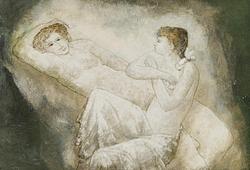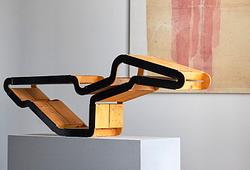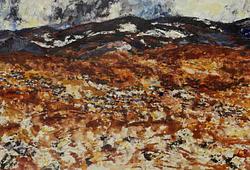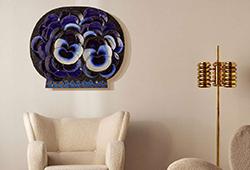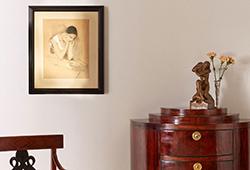Important works by Carl Fredrik Hill at Important Spring Sale
Carl Fredrik Hill
Landscapes from Luc-sur-Mer
The season's Important Spring Sale presents two significant works by Carl Fredrik Hill, created during his short stay in Luc-sur-Mer, Normandy.
In August 1876, Carl Fredrik Hill arrived in Luc-sur-Mer on the North Atlantic coast of France. During the two years he spent in Paris, he initially received favourable reviews and had his first painting accepted for the Salon. The development of the railway enabled Hill to travel extensively between 1873 and 1876. He found a surprisingly new and inspiring subject area in the dramatic surroundings of Luc-sur-Mer. In just under a month, Hill created some of his most powerful and expressive landscape paintings.
Bo Wingren provides the following background: "In the early summer of 1876, Hill was in Montigny, a small town on the Loing near Grez and much frequented by both French and foreign artists. This year was perhaps Hill's most tumultuous and creative period in France. The dark asphalt-color disappears from his palette, painting flourishes, his output is impressive. A certain part of this development must be attributed to Hill's experience of the second Impressionist exhibition that same year. The sun-drenched streets and sand dunes of the Montigny area eventually became too much for Hill. He decided to travel to the coast, an idea he may have gotten from his older friend and patron Gegerfelt." (”Tillbaka till Normandie. Nordiska konstnärer i Normandie 1850 – 1900”, 1992).

› Seashore, Luc-sur-Mer, executed in 1876. Oil on canvas mounted on board, 60 x 74.5 cm.
Why Hill chose Luc-sur-Mer is not clear; medical reasons may have been a factor. Typically for Luc, there was an extremely rich seaweed formation on the beaches, visible only at low tide. This gave Luc a special reputation as a health resort; doctors recommended baths here as particularly invigorating for body and soul. Possibly, the physically and mentally somewhat declining Hill's purpose may have been to strengthen himself with refreshing seaweed baths. In his first letter from Luc-sur-Mer on August 9, 1876, Hill writes: "For a week, I have been painting the Atlantic Ocean, and every time I finish my session, I bathe in the said ocean." Regarding his works, it is mentioned that from morning to evening, he sketches "sea marshes." Wingren continues: "When Hill writes that he paints the sea like a marsh, this is not a poetic metaphor but should be understood literally. When the sea recedes from Luc's beaches at low tide, a teeming world of organisms is exposed, green-black underwater vegetation, water-smoothed rock formations, and hollows hiding shellfish and fish that haven't escaped yet. […] It seems that Hill was constantly fascinated by this spectacle of nature, by the mosaic of color tones that develop here. The phenomenon contributed to unleashing his 'color music.' The sea and the sky—the vast expanse—also played their part in lightening his palette."
Viggo Loos commented on the beach scenes from Luc-sur-Mer, which, according to him, "occupy a remarkable place in our painting's development": "Hill loved this coastal nature. […] In a large group of motifs, he is completely an plein air painter and devotes himself intensively to the study of light, air, the chromatic enchantments of the beach, and the color play of the sea. […] It is the calmness and grandeur of the sea that gripped the painter. […] He himself is aware that he accomplishes something he has not managed before, 'so boldly, so new, so fresh, so unrestrained and yet restrained by a true sense of nature.' […] One understands his own statement, that things take shape when one steps back and sees the light and the air and the color play." Loos continues by describing the motifs where "the green sea stripe turns into a silvery-white string" and the artist "immediately" and "intensely" captures "the August day's heat as a shimmering haze over the sea and coast under the bright summer sky. If ever the term 'impression' can be used, it is here." (”Friluftsmåleriets genombrott i svensk konst 1860 – 1885”, 1945).

› Kustlandskap, Luc sur Mer (mot la Falaise de Lion sur Mer), executed in 1876. Oil on cardboard panel, 37 x 45 cm.
Hill himself wrote: "There is no more resemblance between what I have previously done and what I am now doing than between night and day. As heavy, dark, and gloomy as my opuses have been so far, they are now as bright, light, and airy. Asphalt is completely banned. But what may make people find it difficult to understand is that I have set up as the first and necessary logistical rule: not to execute." This reasoning ties in with the letter Hill wrote home to Sweden a few weeks earlier: "I have now come to the conviction that in art, nothing else is to be sought but the true, le vrai."
Erik Blomberg adds the following perspective regarding Hill's coastal motifs: "What one must admire, not least in these dazzlingly fresh canvases, is the incredibly lively brushwork: the variation between smooth and pasty passages, the black touches that not only mark the scattered seaweed belts but also give relief to the light. It is a technique that never becomes an end in itself, entirely in the service of nature, to give renewed life to the elements, to the moment when sunlight like a dazzling flash strikes a silver streak in the emerald, green sea." (”Carl Fredrik Hill. Hans friska och sjuka konst”, 1949).
During the latter part of his life, Hill returns to the memory of his short but extremely important stay in Luc-sur-Mer:
"At Luc, I saw the high vault blue
So topaz blue and shimmering still...
In the sun, the ebb's white banks gleamed
And seagulls flew over the beach's anchor...
In the sun, the ebb's kisses shimmering
And the ripple on the beautiful surface sparkling
Is like diamonds in ethereal light..."
The "ethereal light" mentioned by Hill brings to mind Sixten Strömbom's description of Hill's almost otherworldly emotional experience during his time in Luc-sur-Mer: "Hill was now rapidly moving towards the zenith of his creativity. […] The colorful light play of the vast expanses and coastal formations forced out his essence's innermost drive, his longing for the simplicity of greatness and an almost ecstatically heightened sense of life" (”Konstnärsförbundets historia I”, 1945).

› Postcard from Lion-sur-Mer, unknown photographer.

Coastal Landscape, Luc-sur-Mer (towards the Cliff of Lion-sur-Mer)
Estimate 500 000 - 700 000 SEK
To the work

The works will be sold at Important Spring Sale
Viewing: 5 – 10 juni, Berzelii Park 1, Stockholm
Open: weekdays 11 am – 6 pm, weekends 11 am – 4 pm
Live auction: June 11 – 13, Arsenalsgatan 2, Stockholm
Read more about Important Spring Sale and see the full catalogue
Requests & condition reports Contact specialist

Tukholma
Andreas Rydén
Varatoimitusjohtaja, Johtava asiantuntija, taide
+46 (0)728 58 71 39

Tukholma
Lena Rydén
Johtava taideasiantuntija, moderni- ja 1800-luvun taide
+46 (0)707 78 35 71
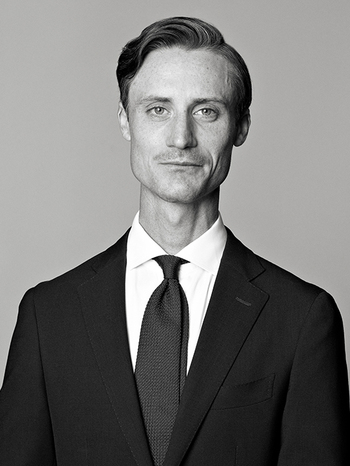
Tukholma
Mark Sjöberg
Asiantuntija taide & taidegrafiikka
+46 (0) 707 88 84 72




